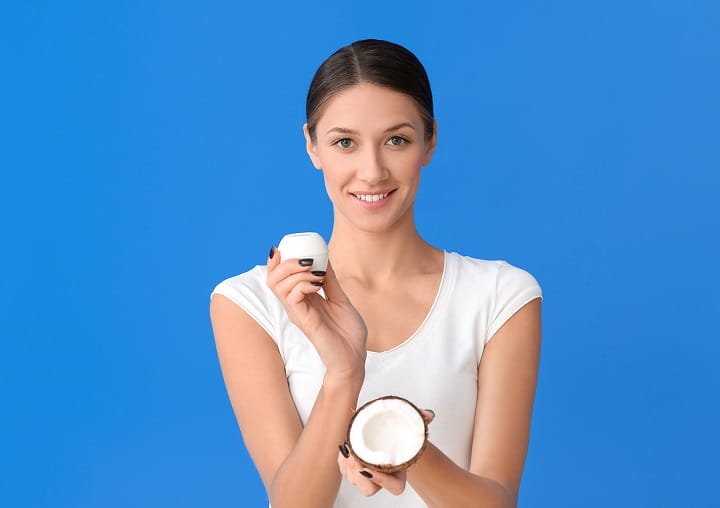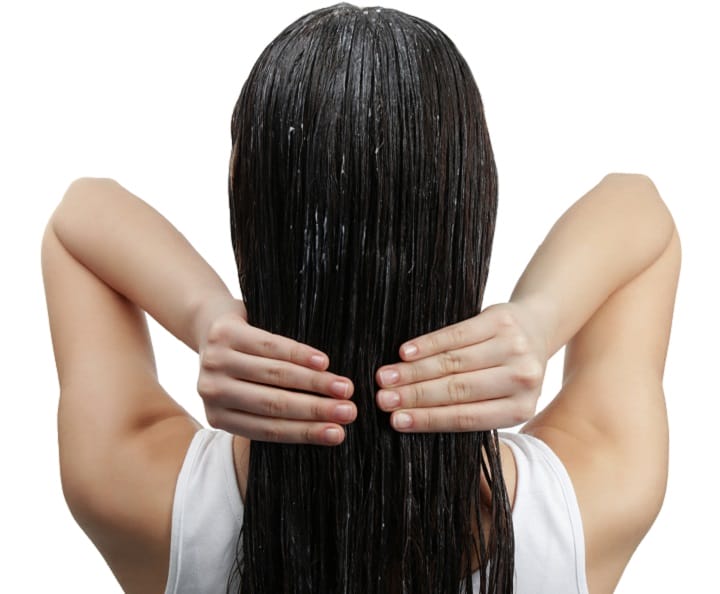Coconut oil ruined my hair – that is something you do not usually hear, especially since coconut oil has a lot of wonders and benefits.
However, note that you can only enjoy the benefits of coconut oil if you use it in moderation.
If you use too much of a good thing, it can lead to lots of consequences.
Table Of Contents
How Can Coconut Oil Ruin Your Hair
Clogged Pores
Coconut oil is a comedogenic substance, meaning the skin can’t readily absorb it. Its thick consistency makes coconut oil clog skin pores quickly. If you are prone to acne, using too much coconut oil on your hair will clog the pores in your scalp and cause acne breakouts.
Scalp Irritation
Aside from acne, coconut oil may even cause severe irritation in the scalp. If you have sensitive skin, even using hair products containing a small amount of oil can trigger scalp dermatitis.
This can cause the skin on your scalp to get dry, red, and itchy. This can get even worse if you use coconut oil on its own.
Protein Build-Up
Another reason why you should not overdo it with coconut oil is because it can cause too much protein build-up in the hair follicles. If your hair gets too much protein, there is an excellent possibility that it will end up looking dry and brittle.
This can cause severe split ends and, eventually, break the strands. If you have modern peekaboo hair, this will be a problem because dandruff will fly every time you expose the colors.
Hair Loss
This is the worst-case scenario for those who overuse coconut oil. If the scalp irritation and protein buildup in the follicles is allowed to get worse, it will eventually lead to hair loss.
If the scalp irritation worsens, the follicles will be severely damaged, so much so that they will not be able to regrow hair strands.
How to Use Coconut Oil for the Best Results
You can get the best results from using coconut oil by applying it to your hair in the form of the following:
Coconut Oil Hair Mask
Step 1 – Warm the coconut oil a bit
It congeals easily, so it may harden if just a degree or two colder than room temperature. So, if it has solidified inside its container, don’t worry, as it is still usable.
Take a bit of the hardened coconut oil (no more than a teaspoon) and place it in a small microwaveable container. Microwave the oil for 10 to 20 seconds or until the coconut oil melts.
Step 2 – Use a big-toothed comb
Or use a detangler to distribute the coconut oil through your hair evenly. Start applying it around the middle of your head and then around your ears. You can then continue with the rest of your hair until the end.
You can also place a little oil on your fingertips and massage the oil into your scalp.
Step 3 – Leave the mask on for at least 30 minutes
If you want a quick conditioning treatment, apply coconut oil before you wash your hair. Think of it as a pre-conditioning treatment. Leave the coconut oil mask for at least 30 minutes before you head into the shower.
If you want deep conditioning, you may want to leave it in your hair overnight. Wear a shower cap to protect your pillowcases and allow the oil to penetrate deeper into your hair. Wash your hair as you usually would in the morning. This will leave you with silky and smooth hair.
Coconut Hair Oil
Step 1 – Warm the coconut oil
When you use coconut oil for your hair regularly, you will use a significantly less amount than when you use it as a mask.
If the coconut oil is not that hard, you do not need to microwave it. Just scrape a small bit around the size of a pea using your fingernail and rub it in between your palms.
The heat from your hands will be enough to melt the small amount of coconut oil; once the oil melts and emulsifiers, run your fingers through your damp hair.
You do not need to make your hair shiny with oil. Make sure the strands get even a small amount of coconut oil. Use more when your palms are dry and there are still some hair strands that you have not coated yet.
Step 2 – Style your hair as usual
After applying a very thin layer of coconut oil to your hair, you can style it the way you want. You may try different mixed-girl hairstyles with this. Dry your hair thoroughly using a towel before combing and styling your hair.
This will remove the excess coconut oil in your hair and scalp. If using a hair dryer, you should set the heat low and dry your hair slowly.
How to Repair Hair Damaged by Coconut Oil
Step 1 – Cut back on the coconut oil
The best thing to do is stop using it immediately when you notice that your hair is getting dry and brittle, even though you regularly use coconut oil. On the other hand, if you do not want to stop, then at least significantly limit the number of times you use it.
Step 2 – Deep-clean your hair
Use a clarifying shampoo to remove as much of the coconut oil buildup in your hair and scalp. This will stop the damage from getting even worse.
Step 3 – Apply a deep conditioner
After washing your hair, apply a deep conditioner to remove the moisture that was sapped away. From this point, consider using significantly less coconut oil and applying it less regularly.
Coconut Oil Alternatives
If you are too traumatized from using coconut oil again, here are some viable alternatives that you can replace it with:
Olive Oil
Like coconut oil, when used in moderation, olive oil can also moisturize and strengthen the hair. However, olive oil might be a bit too heavy if you have thin and damage-prone hair. It is also comedogenic, so you should avoid getting it on your scalp as much as possible.
Jojoba Oil
This oil has more vitamins and minerals than coconut oil, so it can help strengthen your hair and grow faster. However, jojoba oil is quite thick, so you should use it sparingly.
Argan Oil
Probably the best alternative to coconut oil is argan oil. This oil has excellent moisturizing properties and provides your hair with excellent protection against daily damage. It is also much lighter than coconut oil, so your scalp can absorb it easily without clogging your skin’s pores.
FAQ
Can the hair damage made by coconut oil be reversed?
Yes, you can stop the damage done by the coconut oil on your hair by using a clarifying shampoo. The dryness and brittleness can be reversed using a deep moisturizing hair product.
How do you wash out coconut oil from your hair?
Because coconut oil is so heavy, you will need to rinse your hair first using just water, like when you are doing hair lightening without using bleach. After getting as much of the oil out as you can, you can proceed with a clarifying shampoo.
This will wash away the excess coconut oil from the surface of the strands. Depending on how much coconut oil is in your hair and scalp, you may need to repeat the shampoo once or twice.
Can coconut oil make your hair thicker?
Coconut oil contains many vitamins, minerals, and fatty acids that are essential for the optimum health of your hair and scalp.
These nutrients help keep your hair strong and promote the growth of healthier hair strands. This will keep your hair in optimal condition for easy hairstyles.
How often should you use coconut oil?
Because of how heavy coconut oil is, it is best that you only use it once or twice a week. However, if you have fine hair, you should consider using coconut oil just once a week.
How should coconut oil be applied to the hair?
When applying coconut oil to your hair, it is best to do it a little at once. Start with a dime-sized amount on your palms and thoroughly massage it into your hair.
Only add more if your hands come out dry and still; parts of your hair need coconut oil. Do not use so much oil that your hair and scalp feel greasy.
Michele Meesh Antunes is the lady of the Beardoholic writers team and a genius when it comes to hair and beard styles that suit any face shape. She’s been a barber for years now and, no matter your personal style, she knows exactly what beard, hairstyle and length suit you. She brings the women’s perspective on beards, beard care, haircuts and hairstyles and male grooming.



